We went for a day trip from Sighişoara to visit the Biertan Fortified Church. The village of Biertan, including the fortress church, is a UNESCO World Heritage Site.
The nearest large town is Sighişoara, but due to limited transport options, we had to hitchhike to get there and to go back to Sighişoara.
In this post, I am going to share about how to access to Biertan and the highlights of the Biertan Fortified Church. I also mention the village of Copša Mare, which is located near Biertan.
About the Biertan Fortified Church
Biertan Fortified Church is a Lutheran church in Biertan, Sibiu. It was built by the German-Saxon community who had settled in Transylvania at the time. It was originally built as a Roman Catholic church, and became an Evangelical Lutheran church after the Reformation. In 1993 the town of Biertan, including the fortified church, was inscribed on UNESCO’s World Heritage List.
The church is surrounded by triple fortification walls and contains six fortified towers. The centrally located church is placed on the highest position. The specific date of the start of construction is not known, but the first record found relating to this church dates from 1486.
Getting to Biertan Fortified Church from Sighişoara
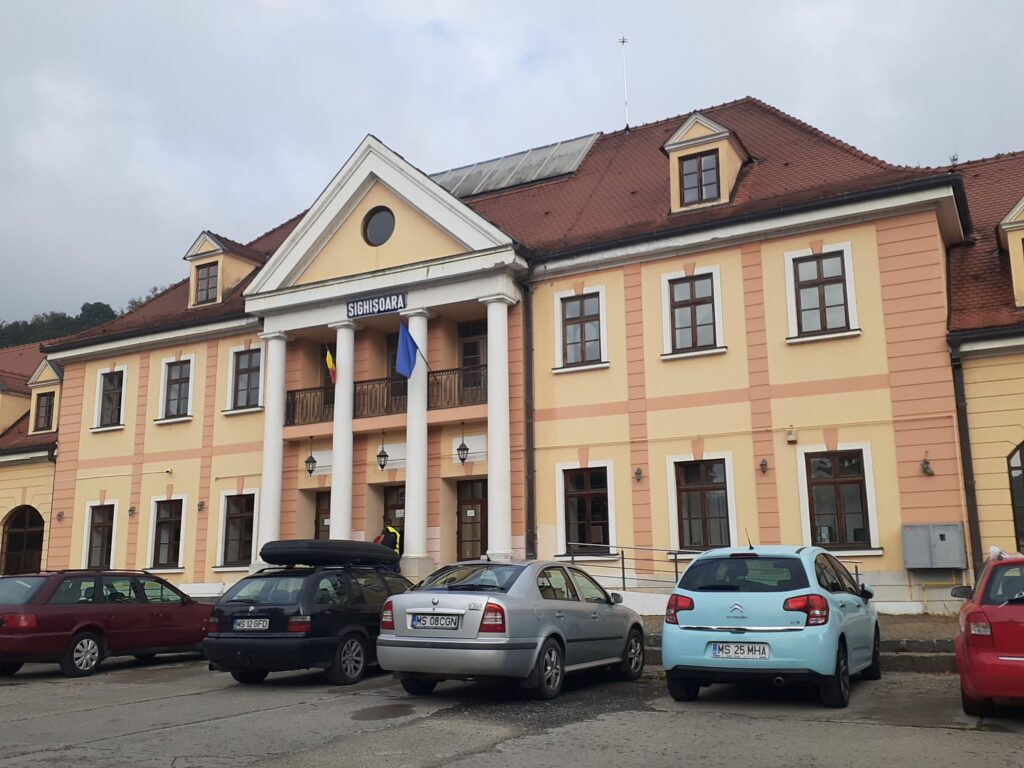
Getting from Sighişoara to Biertan is a bit tricky. First, we took the train from Sighişoara to Dumbrăveni.
Sighişoara to Dumbrăveni
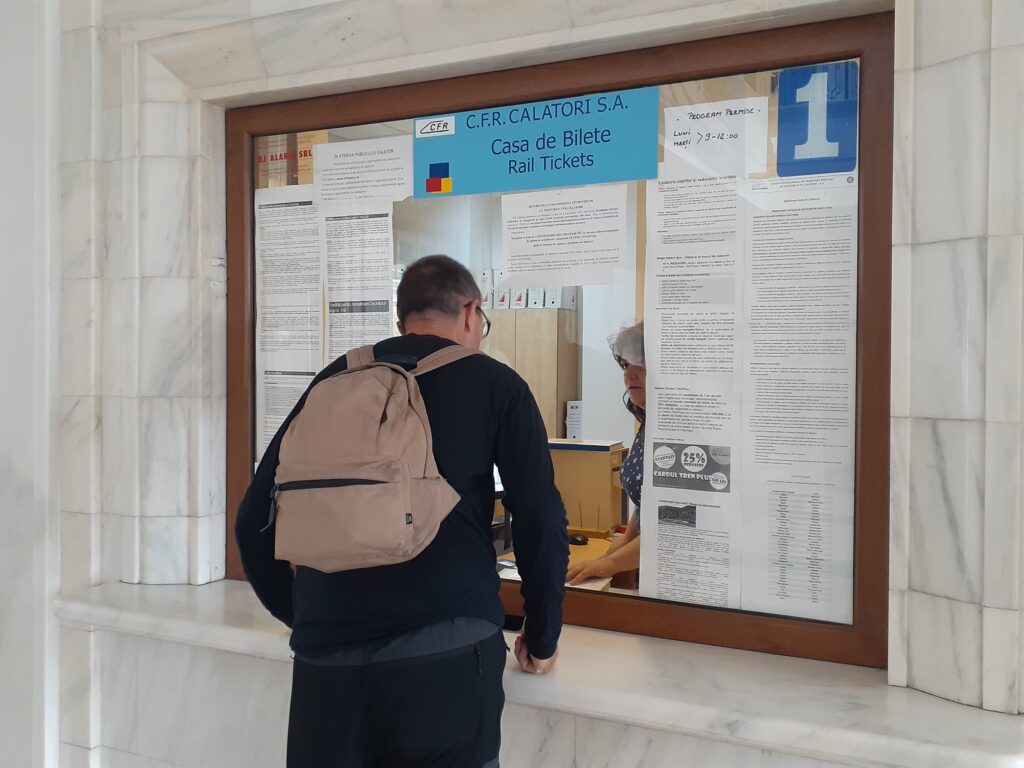
There was a train leaving Sighişoara railway station at 10:13 am, so we decided to take that.
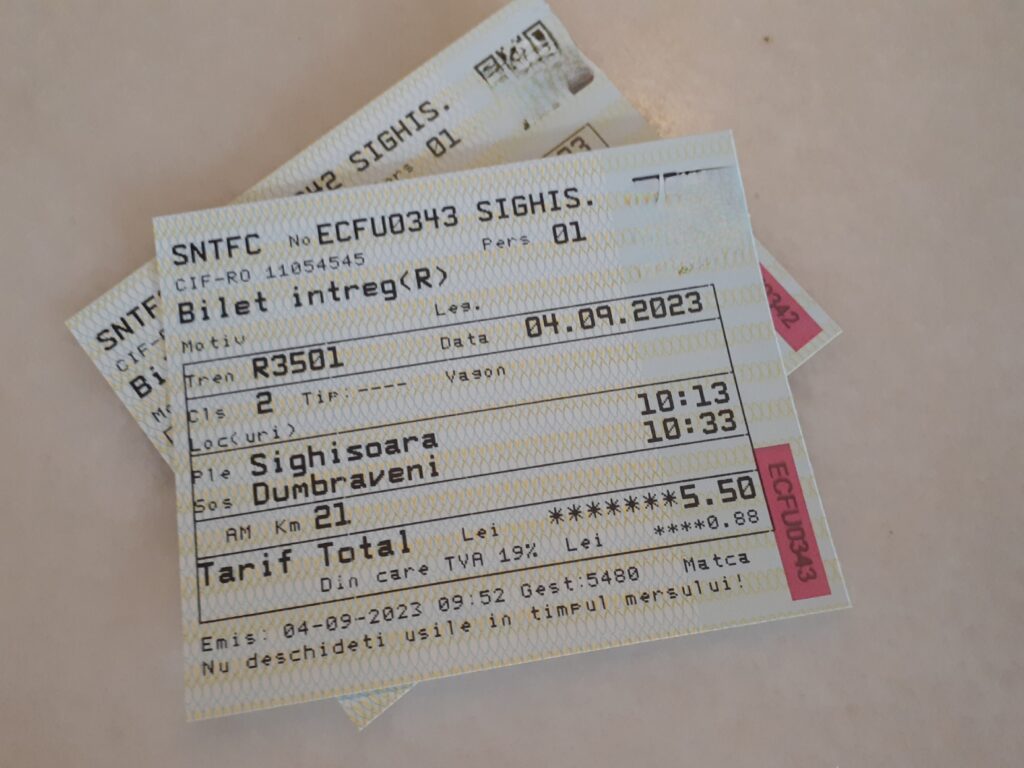
The journey from Sighişoara to Dumbrăveni was 21 km and cost 5.5 lei per person. The train journey takes 20 minutes.
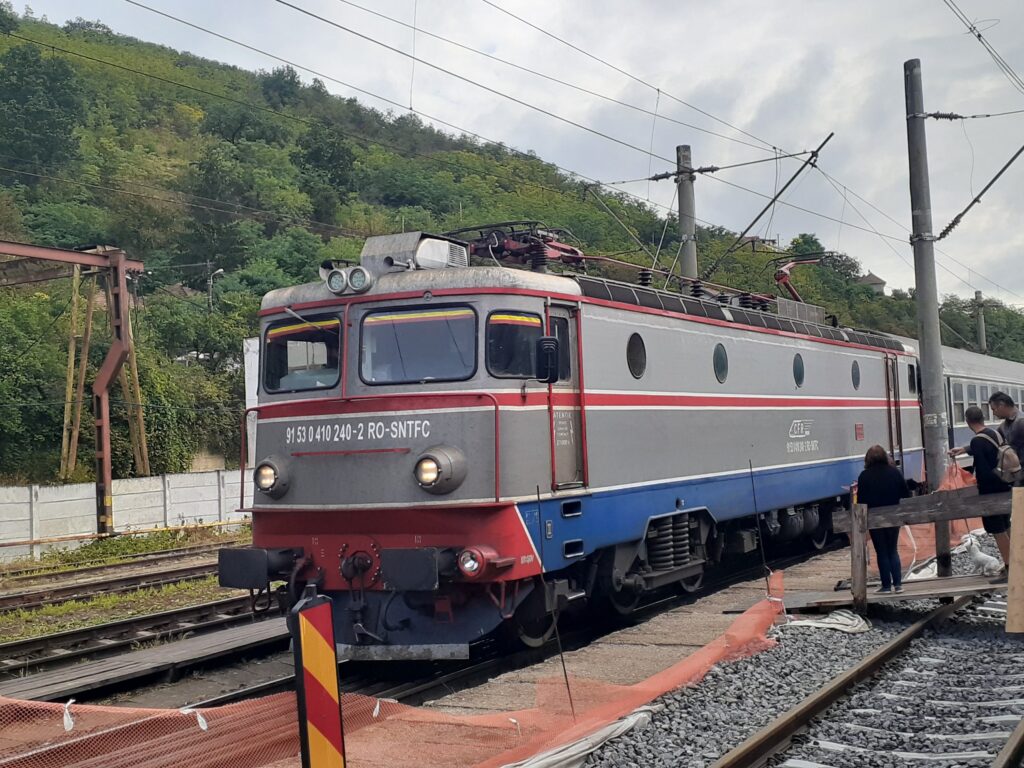
Sighişoara station was under construction on the platform and we had to cross a temporary wooden bridge to get to the platform where our train was coming. After a short wait, the train came in. The seats were unreserved, so we sat wherever we wanted.
The train left Sighişoara at the scheduled time and arrived at Dumbrăveni 20 minutes later.
Hitchhiking from Dumbrăveni to the crossing to the village of Biertan
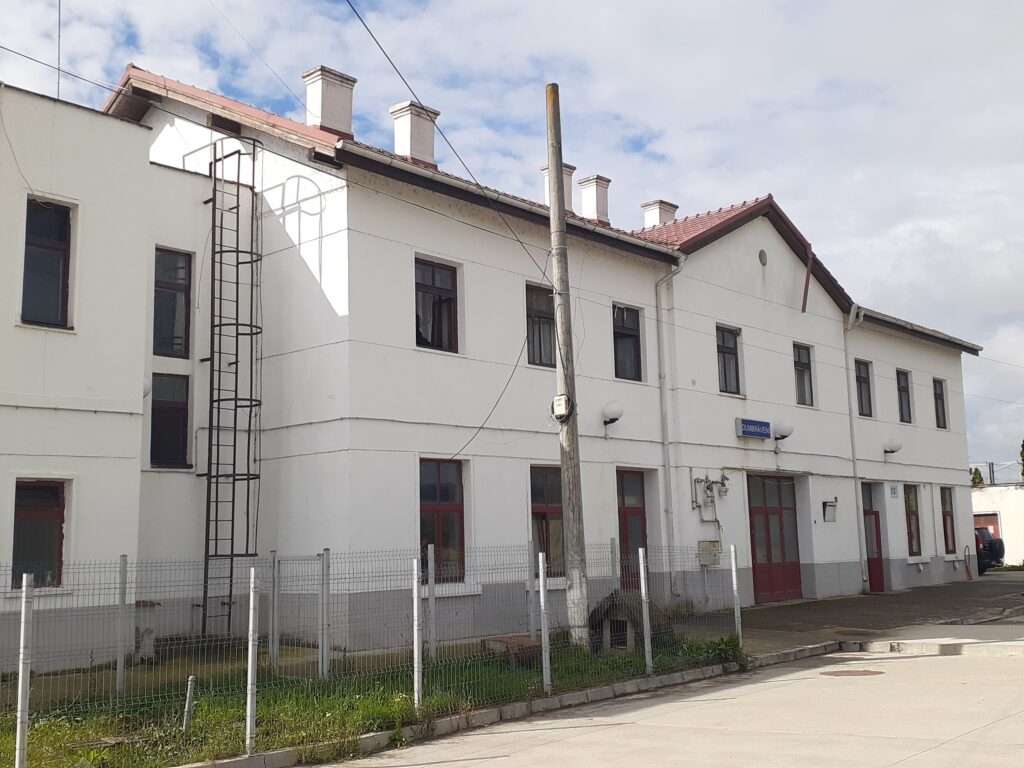
There is no train service from Dumbrăveni to Biertan and it’s not clear if there are ever any buses. Dumbrăveni railway station is a small building and there was nothing resembling a bus stop in front of it. No sign, no vehicle, no people. We didn’t see any vehicle, let alone a taxi, nor any locals. We only saw two people (probably foreign tourists) with small backpacks who were on the same train as us, and got off at the same station, and then, they started walking quickly towards Biertan. I didn’t know if they were going to Biertan Fortified Church or not, but if they were, they looked like they intended to walk there.
The distance from Dunbrăveni station to Biertan Fortified Church is about 15 km, so it is not impossible to walk if you want to, but it takes more than two and a half hours. We wanted to save time and energy if possible, as there was one other place we wanted to visit that day besides the Biertan Fortified Church. Therefore, hitchhiking was the best way.
Although we decided to hitchhike, there were no cars on the road. We started walking in the direction of the Church hoping a car would appear.
During the short walk, a few cars passed by and one of them stopped. It was a couple of locals and they kindly agreed to give us a lift to the intersection before Biertan. On the way, we overtook the two travellers who were on the same train, and we got out of the car at an intersection marked as 8 km to the town of Biertan.
Hitchhiking from the crossing to the village of Biertan
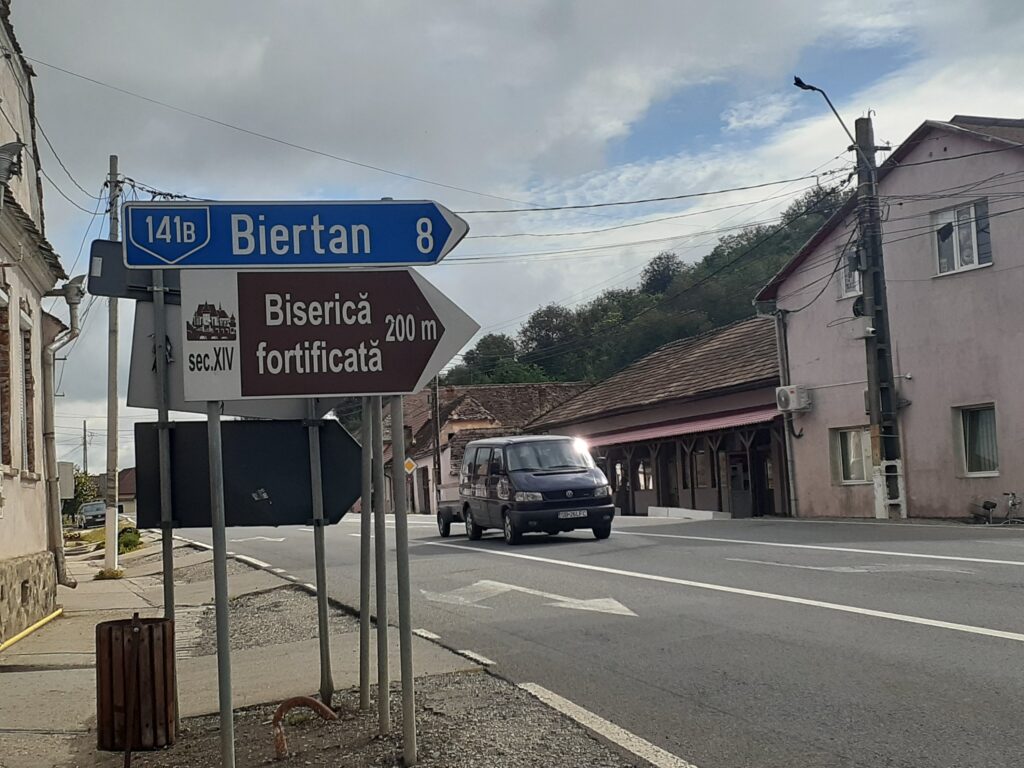
Although we got off at the intersection for Biertan, there was still no traffic and so we decided to continue walking and hitchhiking. After about five minutes of walking, a car stopped. Two local men happily gave us a lift to the Biertan church.
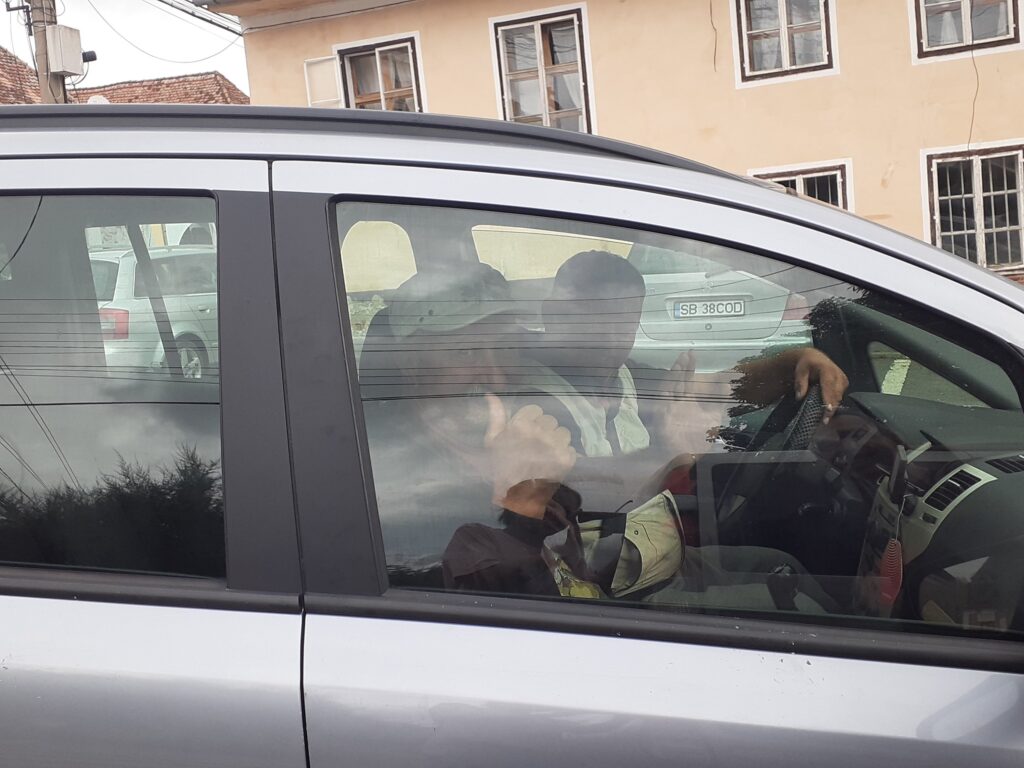
Thanks to these two kind men, we had a smooth ride to the entrance of the Biertan Fortified Church.
Entrance fee to Biertan Fortified Church
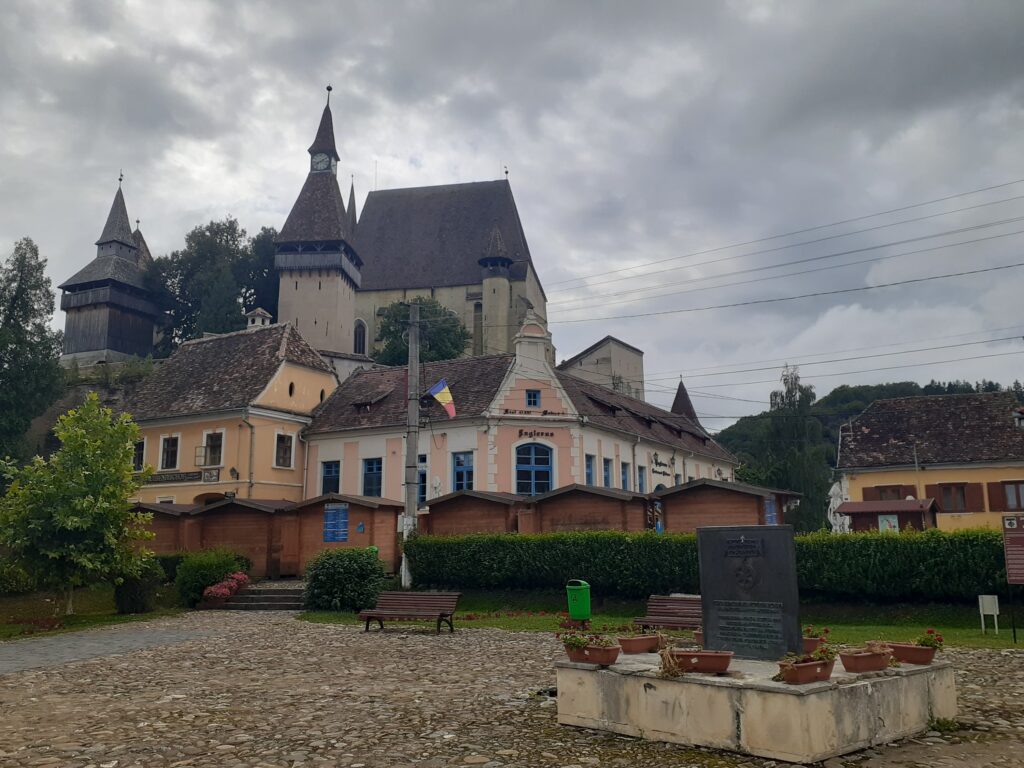
The Biertan Fortified Church is located in a fairly remote area, but as it is a World Heritage Site, it was properly maintained as a tourist attraction. There is a small square near the entrance, with benches and flowerbeds. Many tourists probably visit on tours.
Let’s enter the Biertan Fortified Church now. The ticket office is located in the yellow-walled building. The entrance fee was 15 lei per person.
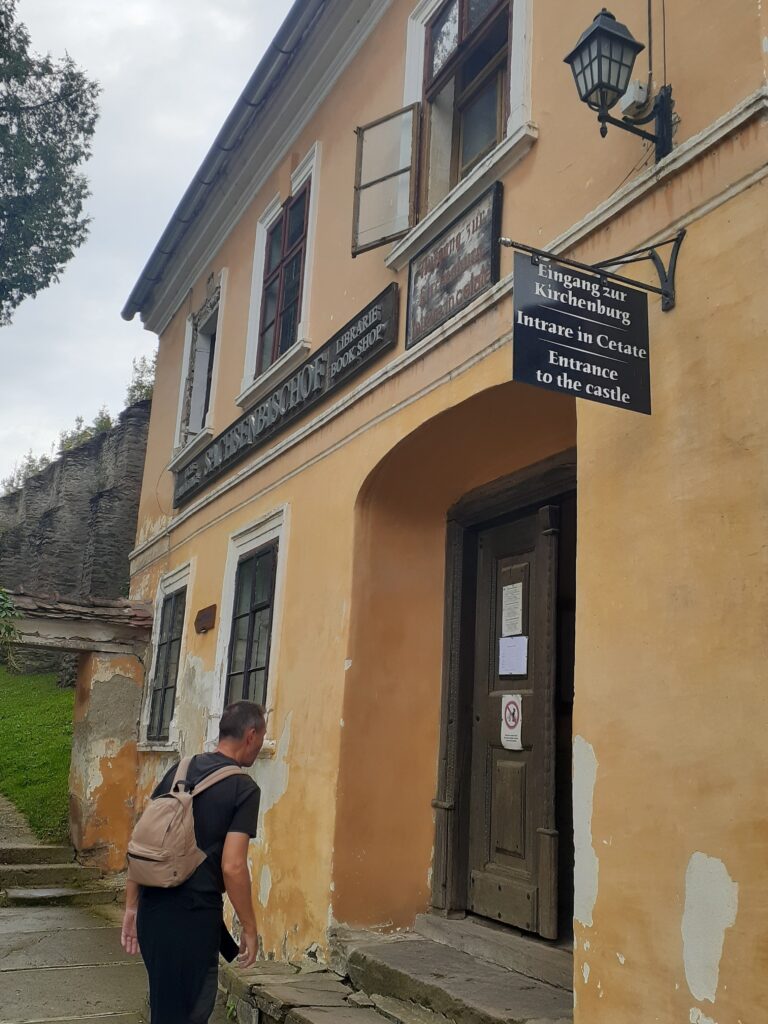
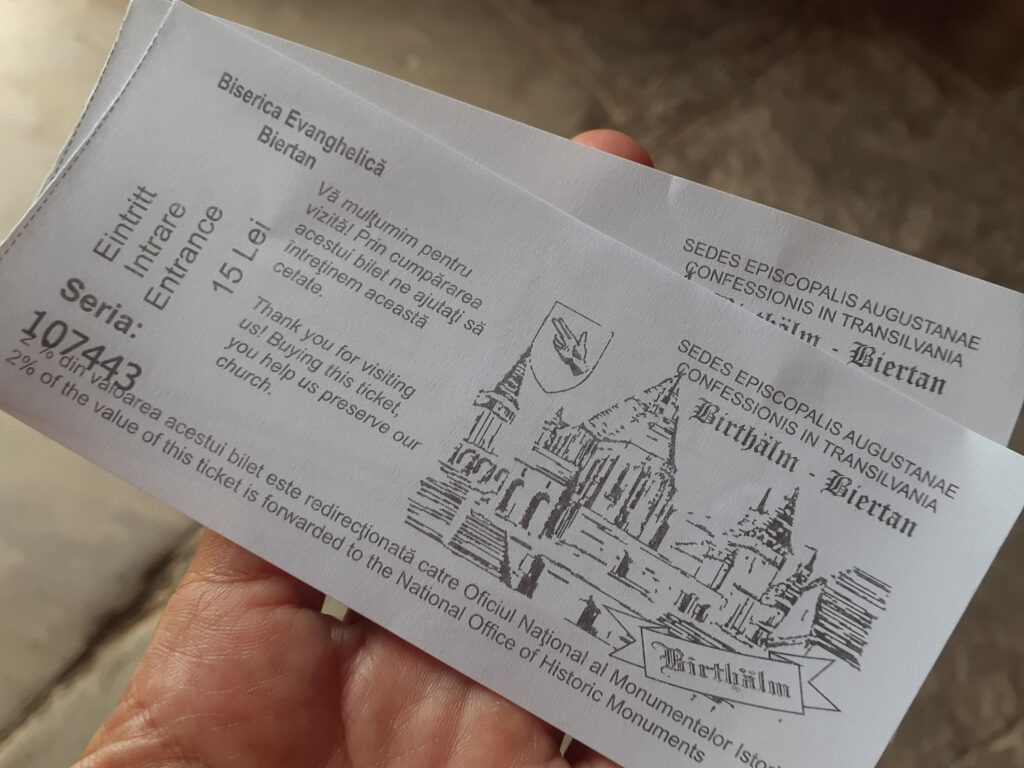
Payment was by cash only. There was a dark tunnel staircase at the back of the ticket office, from where we entered the fortified church.
Highlights of Biertan Fortified Church
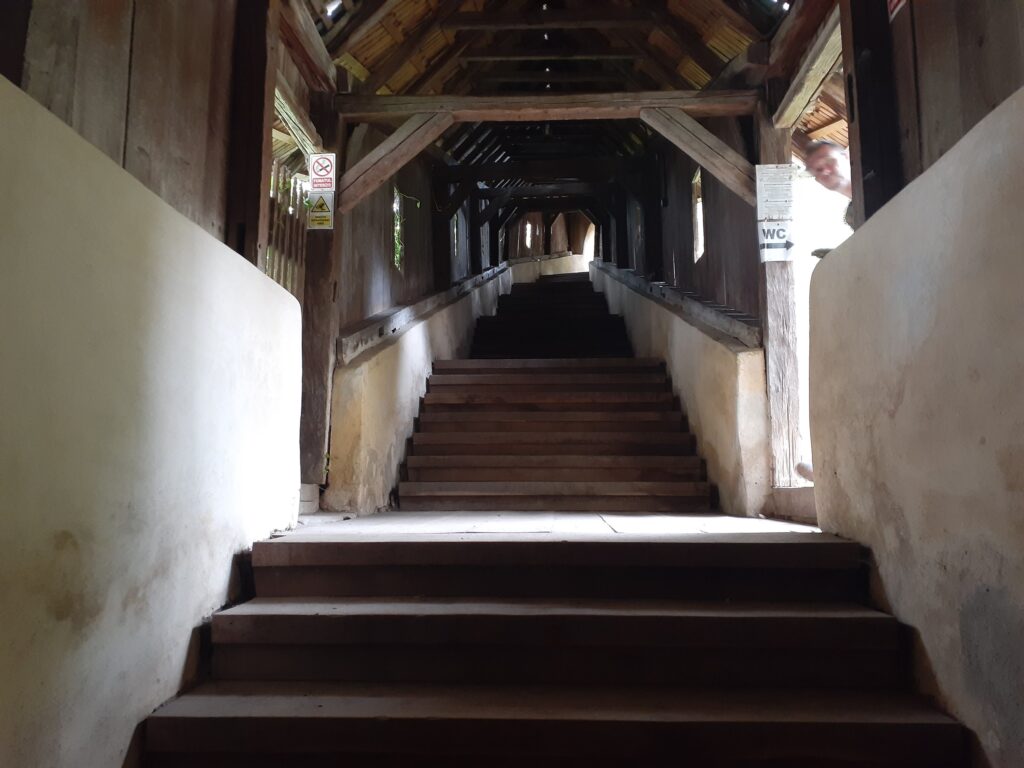
After purchasing a ticket, you can visit the church at the top of the hill by climbing the wooden-roofed staircase.
The Town Hall Tower
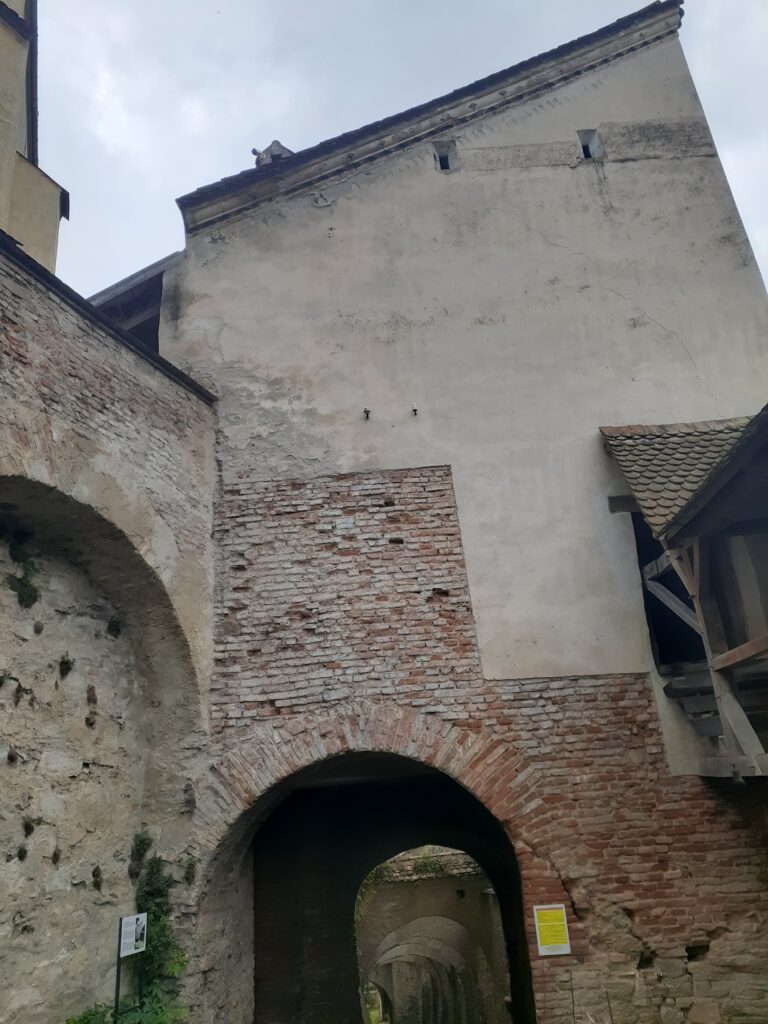
A tower with a sloping roof on one side only, built over three storeys and connected to the second fortification wall. So named because the Town Hall once stood here.
The Northern Tower (Clock Tower)
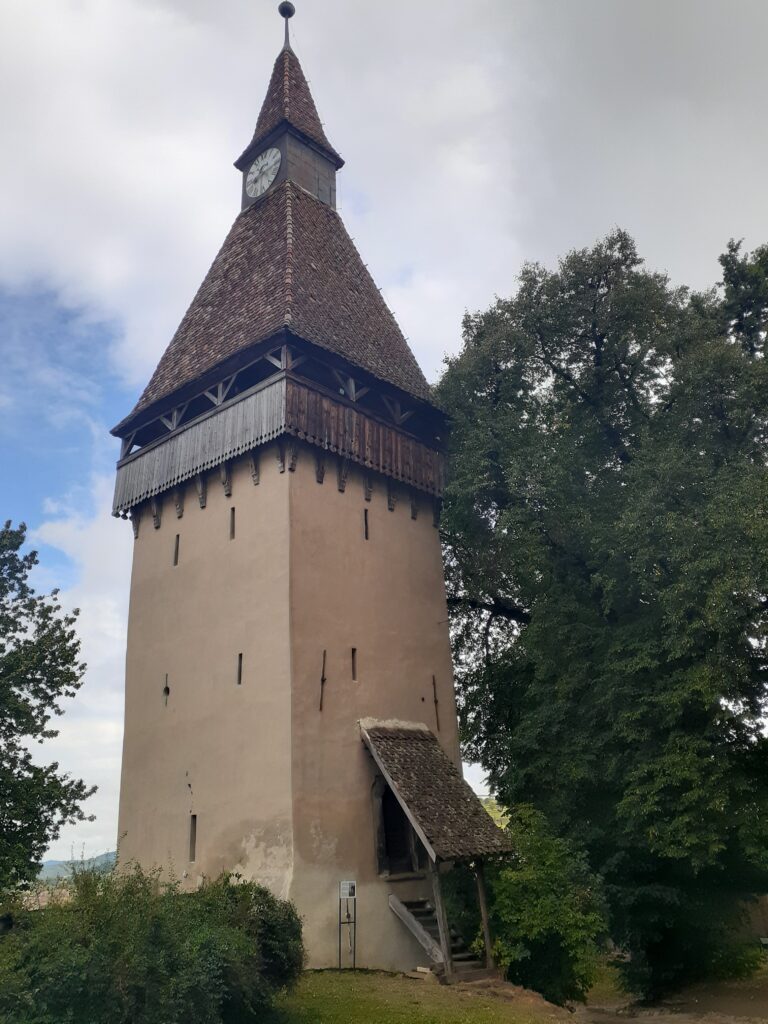
This four-storey clock tower is located to the north of the fortress. It has a wooden walkway and a small tower with a clock on the roof above it.
The Bell Tower
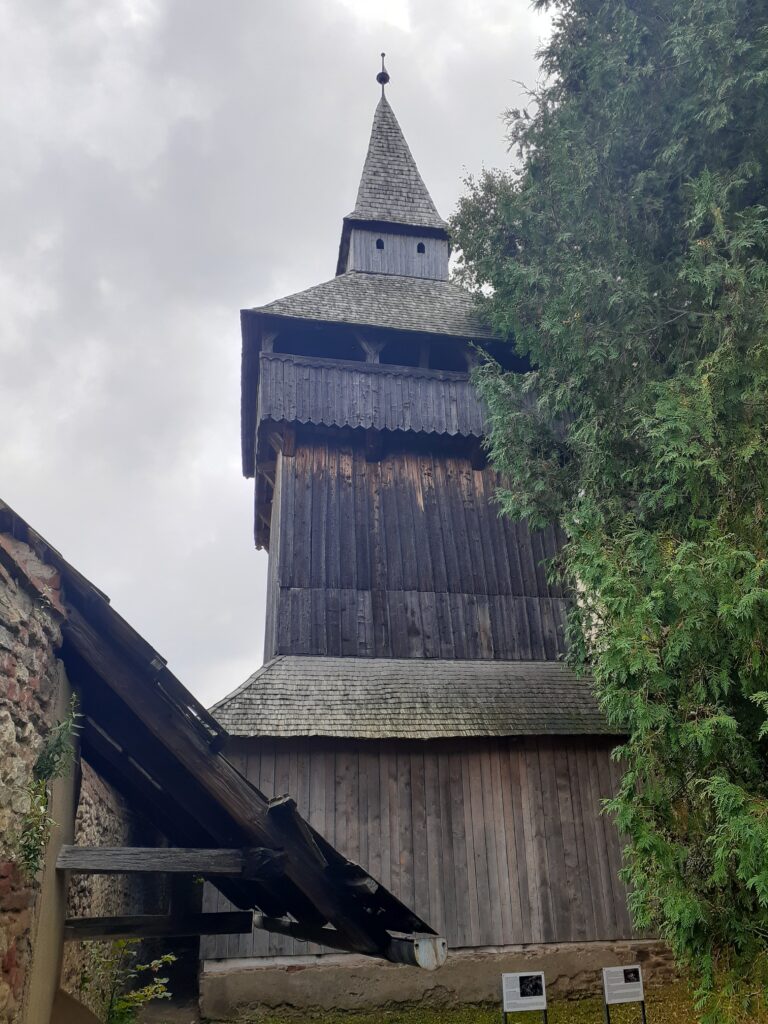
The bell tower on the north side of the church is made of wood and dates from the 18th century.
The Lutheran Church
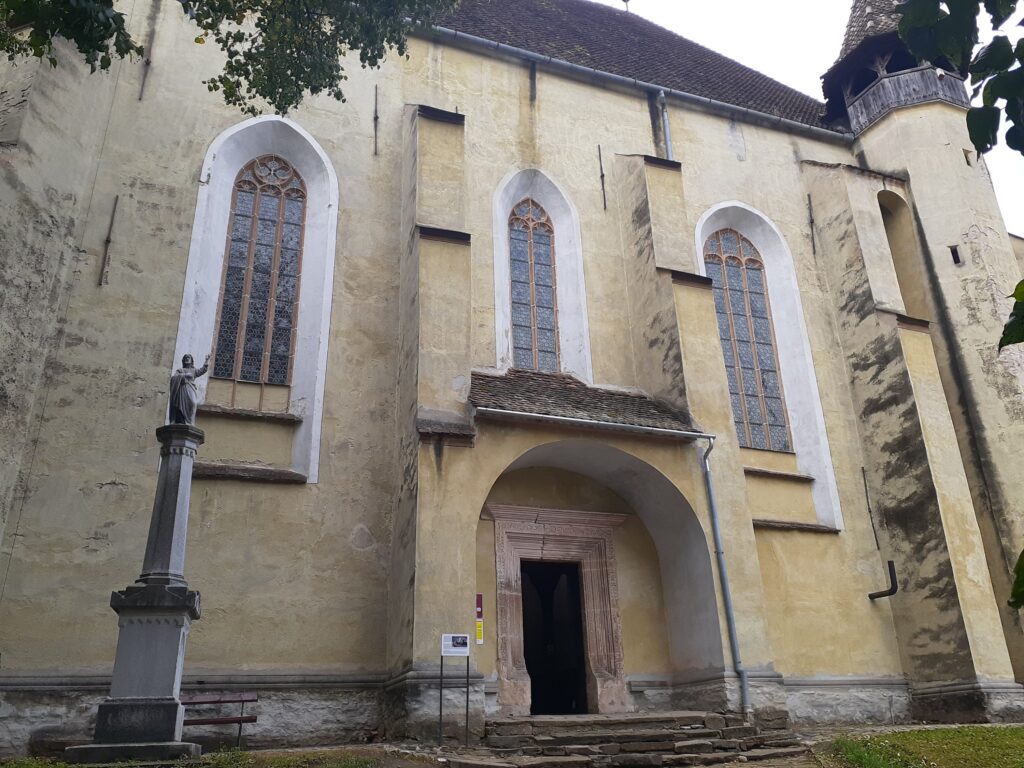
The Lutheran Church is the focal point of the fortress and stands on an elevated position. The date of construction is not known for certain, but it was built in the late Gothic style and is thought to date from around 1500.
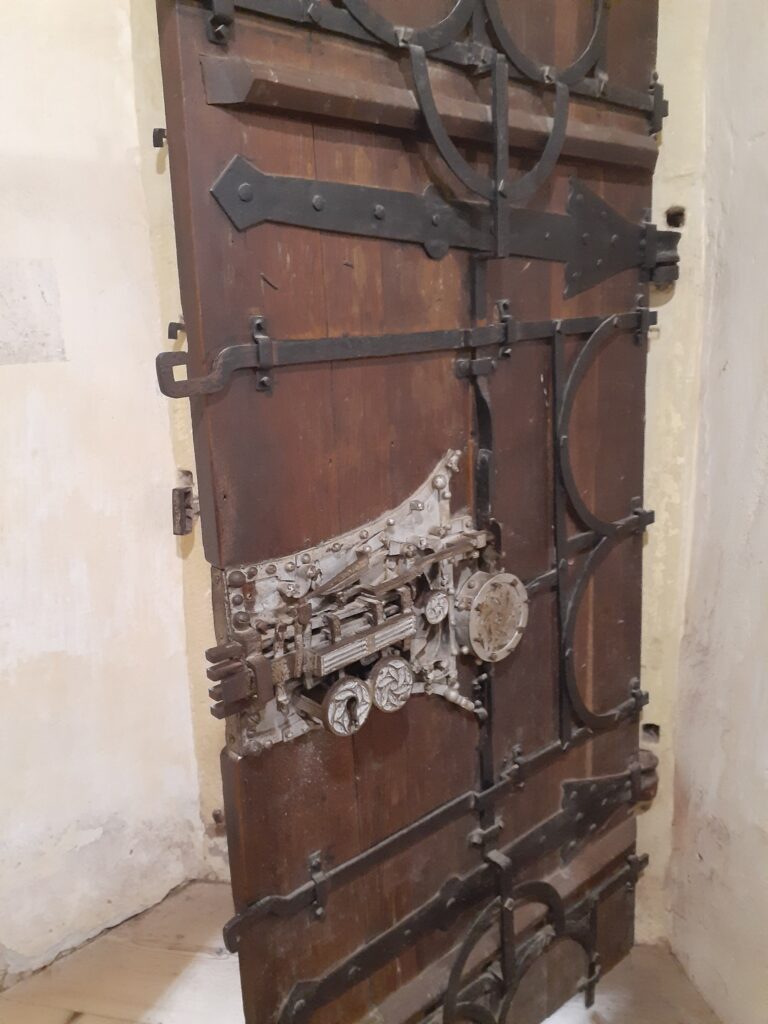
Inside the church there is a special door, which was exhibited at the Paris Exhibition of 1889, made in 1515 by the Sighişoara master Johannes Reishmuth. Its lock is a complex structure containing 15 forked pieces of iron and four bolts. As well as looking at the door from the outside, you should definitely enter the room and observe it from the back.
The Tower Gate of Middle Wall

This pyramid-roofed tower is located near the City Hall tower. The southern middle wall (the second fortification wall) connected to this tower looks impressive.
The Easten Bastion
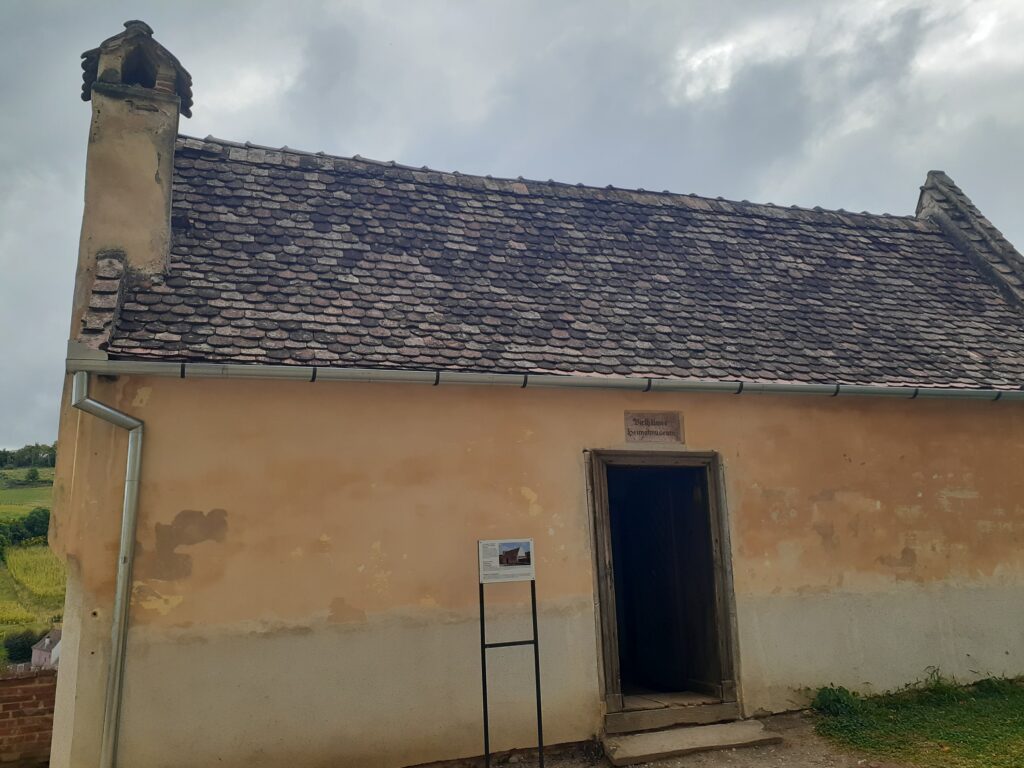
A separate building in the south-eastern part of the fortress was also known as the ‘prison for unhappy couples’. In peacetime, couples who had fallen out were locked up here and not allowed out until they made up. The room had a single bed, table, chair, plate, glass and a spoon, and couples were forced to share them.
Thanks to this, anecdotal evidence suggests that only one couple divorced during the three centuries of the bishop’s presence.
Road to Copşa Mare Fortified Church
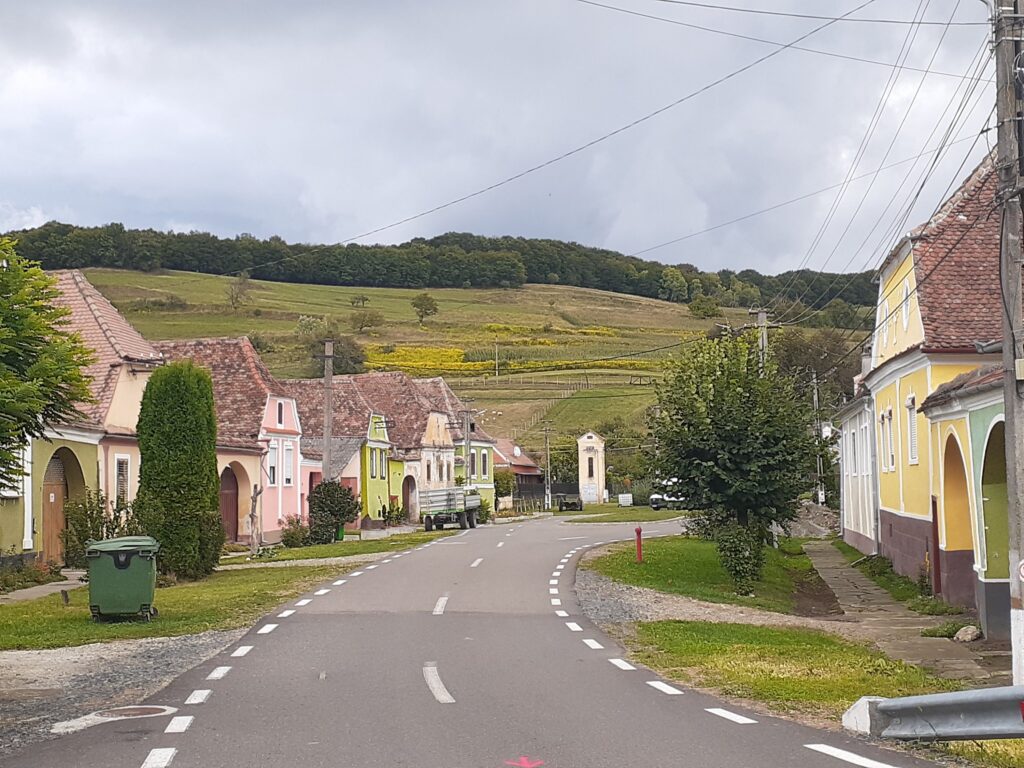
After visiting the Biertan Fortified Church, we went to the Fortified Church in the nearby village of Copşa Mare. The distance from Biertan village to Copşa Mare is just over 3 km, so it’s not too much of a walk.
After leaving the Biertan Fortified church, we walked a short distance along an asphalt road lined with colourful houses and turned into a path with a fence door.
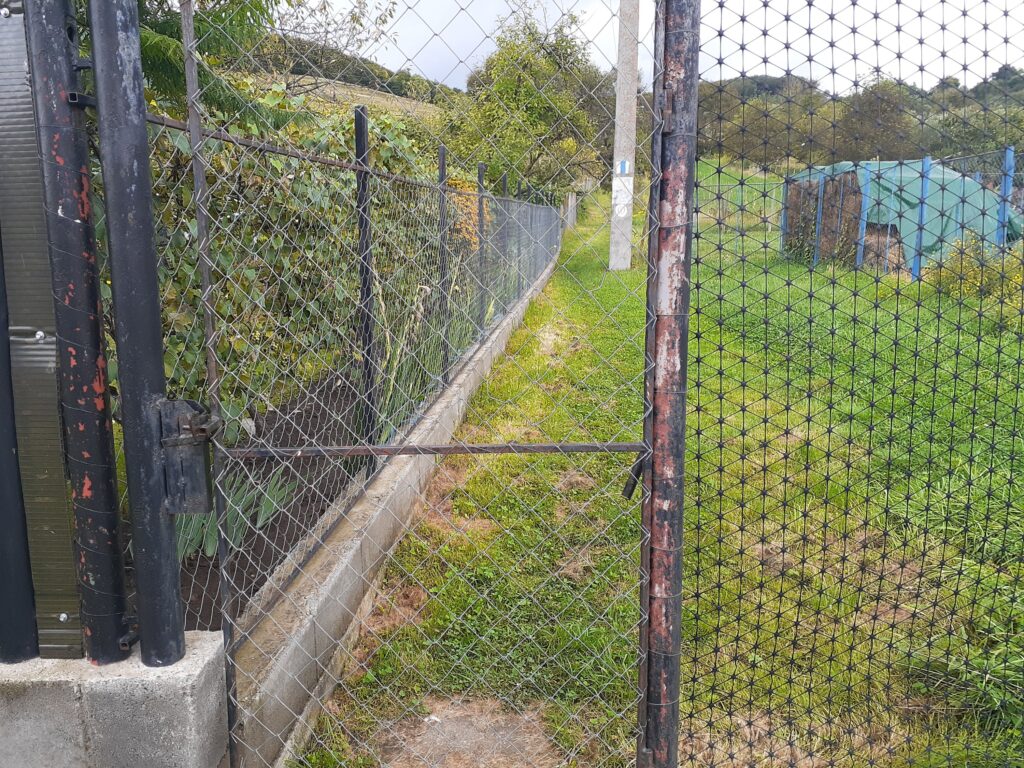
Map.me shows the hiking route. Following this, we walked through the grass and along a path somewhat muddy from the previous day’s rain to the main road.
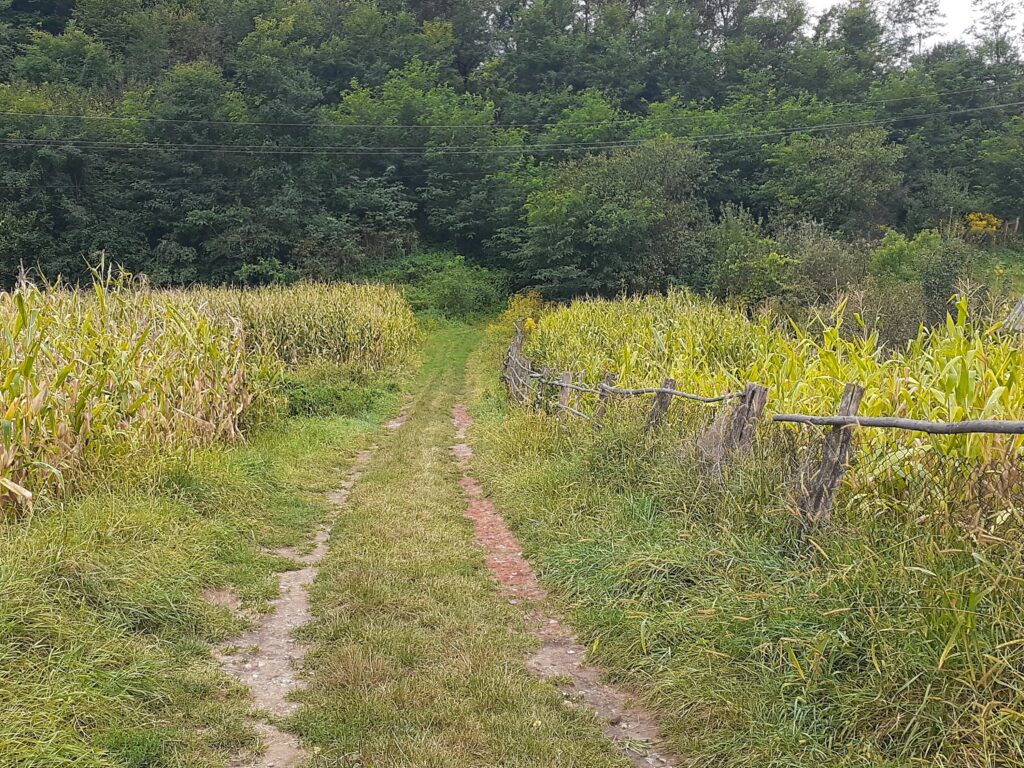
After a short walk we came to a small hill and looking back we had a good view of the whole of the Biertan Fortified Church. It was a little disappointing that the sky was overcast.
It was when we were on the main asphalted road again that a car pulled up and before we could tell them where we were going, they offered us a lift. They were a middle-aged couple who had lived in Spain and spoke fluent Spanish. We were chatting away in the car and in no time at all we were on the access road to the church.
Their house was by the junction and they asked us if we would like to have coffee at their house. We politely declined, as we wanted to get back to Sighişoara before the weather worsened.
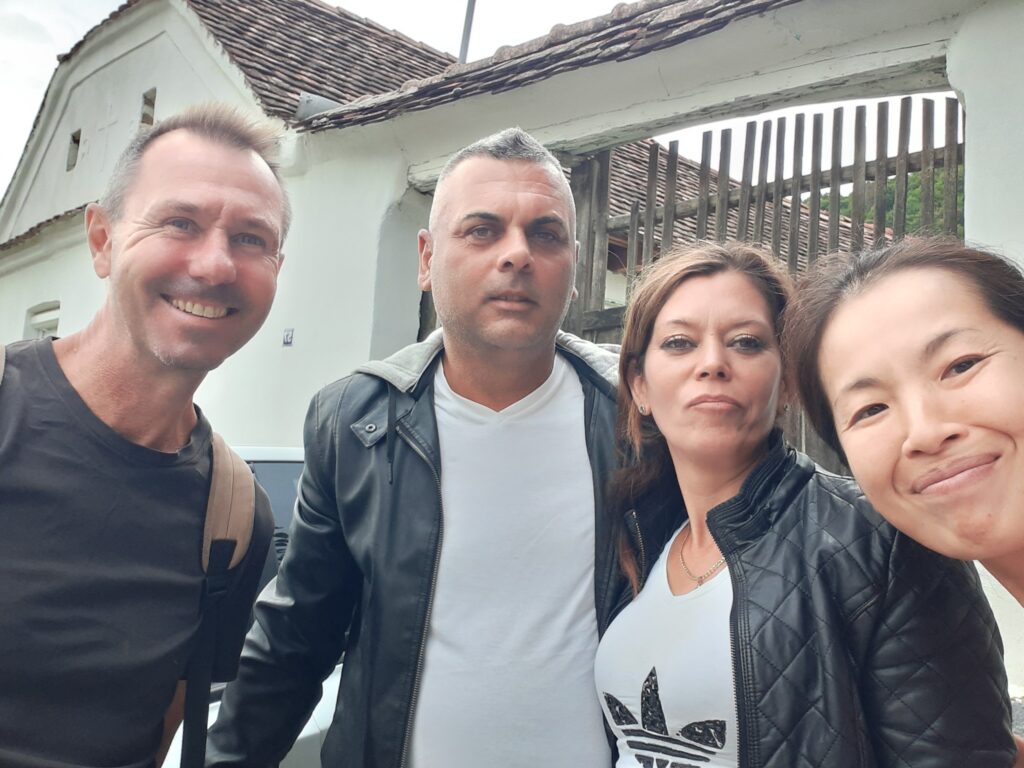
There was a small roundabout with a well, from which we walked to the fortified church.
Copşa Mare Fortified Church
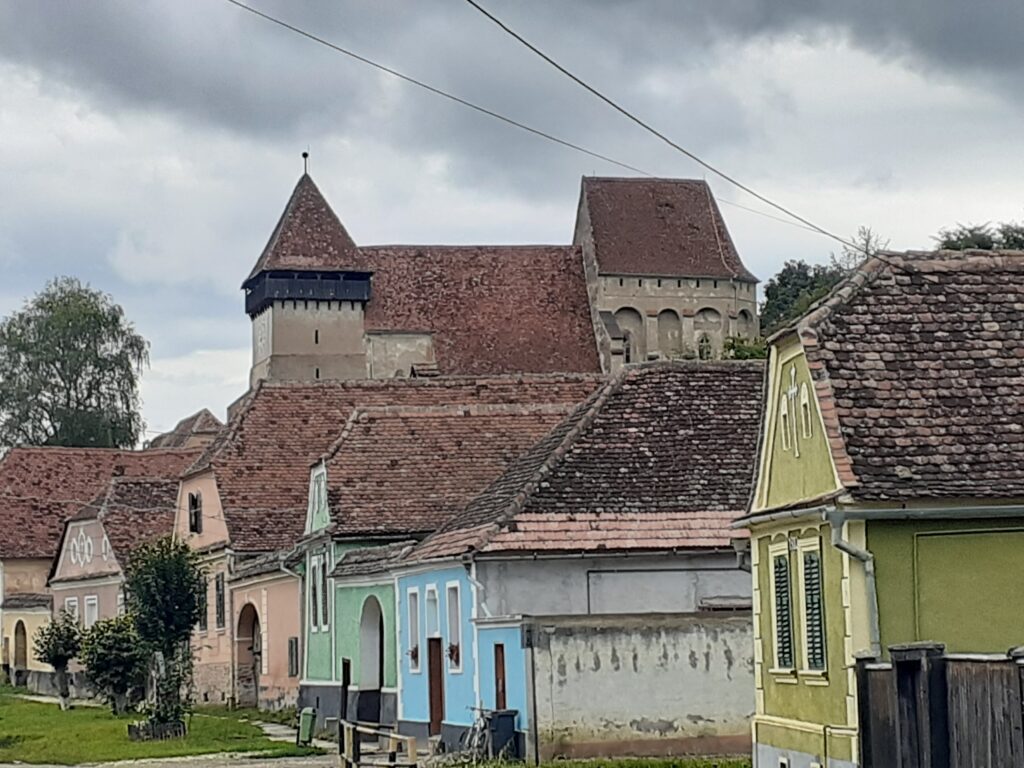
The fortified evangelical church in Copşa Mare, Sibiu, dates from the 14th century.
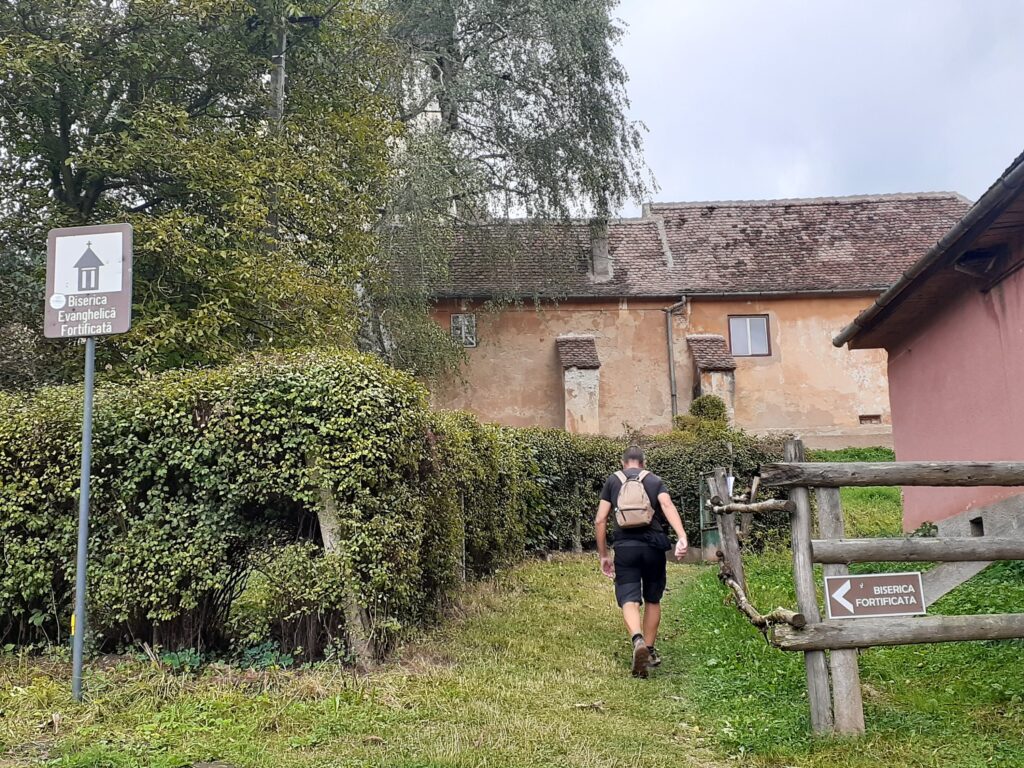
There were no visitors other than us and the gates of the fortified church were closed. It was locked and we couldn’t enter.
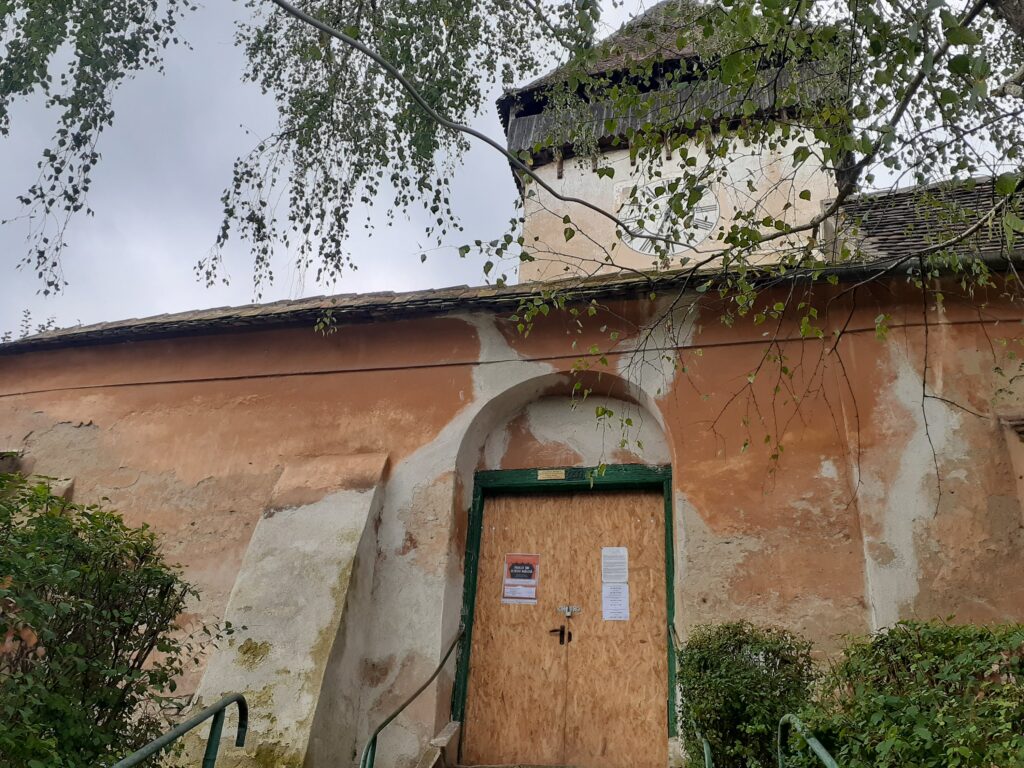
There was a piece of paper on the door with the telephone number of a guide, but we did not want to call someone and to wait for the person coming to get inside. It was a little shame that we cannot visit the inside of the church, but that was enough for us as we enjoyed the journey to get here. We decided to leave the church quietly.
Hitchhiking on the way back to Sighişoara
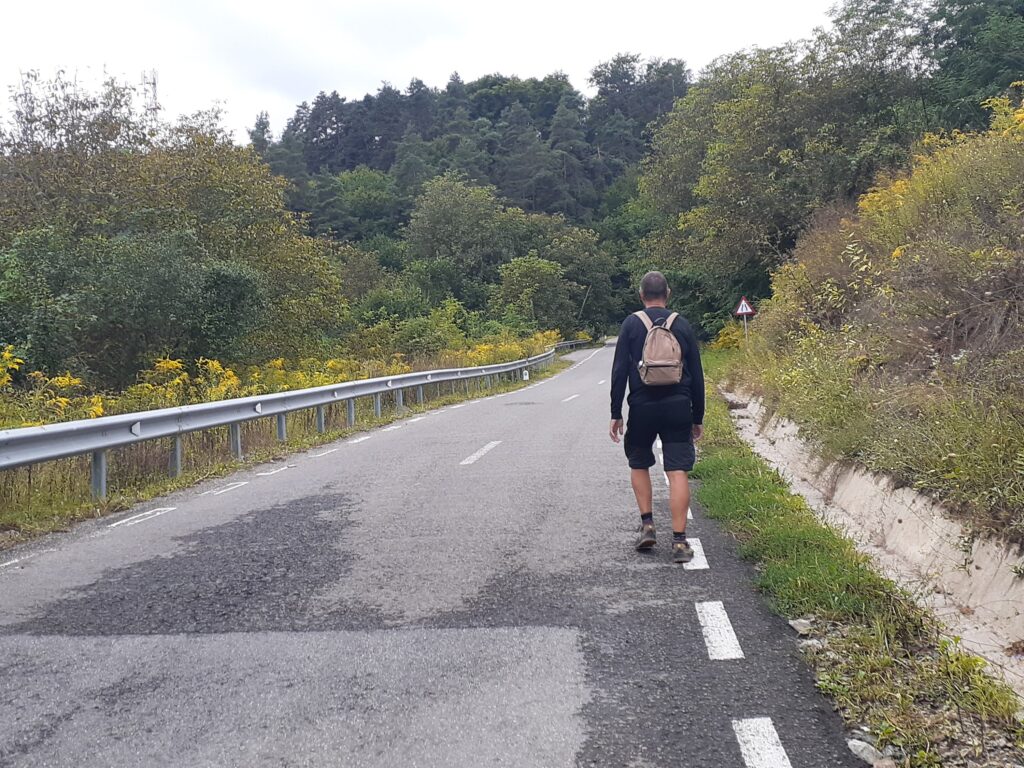
On the way back from Copša Mare, hitchhiking was more difficult than on the way there. Traffic from Copša Mare to Biertan and from Biertan to Dumbrăveni was even less than in the opposite direction. We ended up walking all the way from Copša Mare to Biertan. These two villages are close together, so it wasn’t too hard to walk, but the problem was getting from Biertan to Dumbrăveni. We would have preferred to drive back if we could, but there was not much traffic.
It looked hopeless, and we just kept walking. Then, we suddenly heard the sound of hooves behind us and turned to see what it was, and …
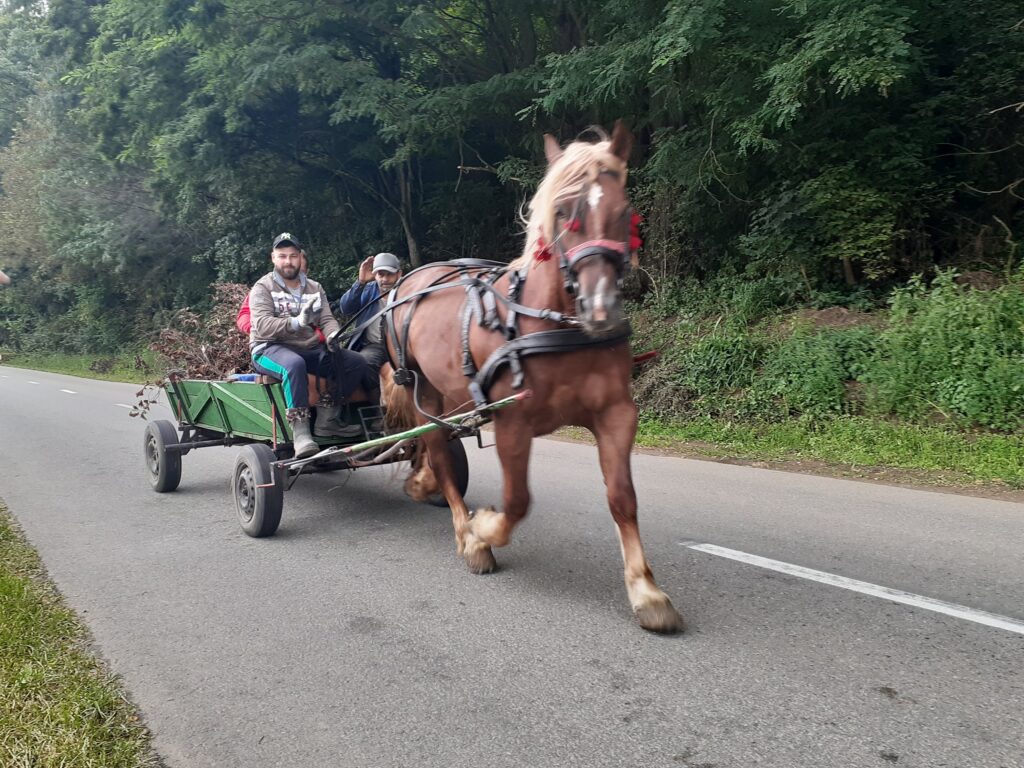
It was three men on a carriage pulled by a horse about to come along. As they passed by us, Mai took their photograph. They raised their hands, slowed down and stopped. The young man sitting on the back of the cart let us get into the back of the carriage.
The young man was a Romanian living in Germany and could speak English, and he said that the people sitting at the front were his uncles. After maybe 2 km, the carriage turned onto a side road and we got out of the carriage there. Now we had made some progress!
Still, as it was far from the railway station, we had to hitchhike again, but where we had got off the road was straight and the cars were going very fast. It was tough to get cars to stop in that situation, even if there were cars on the road.
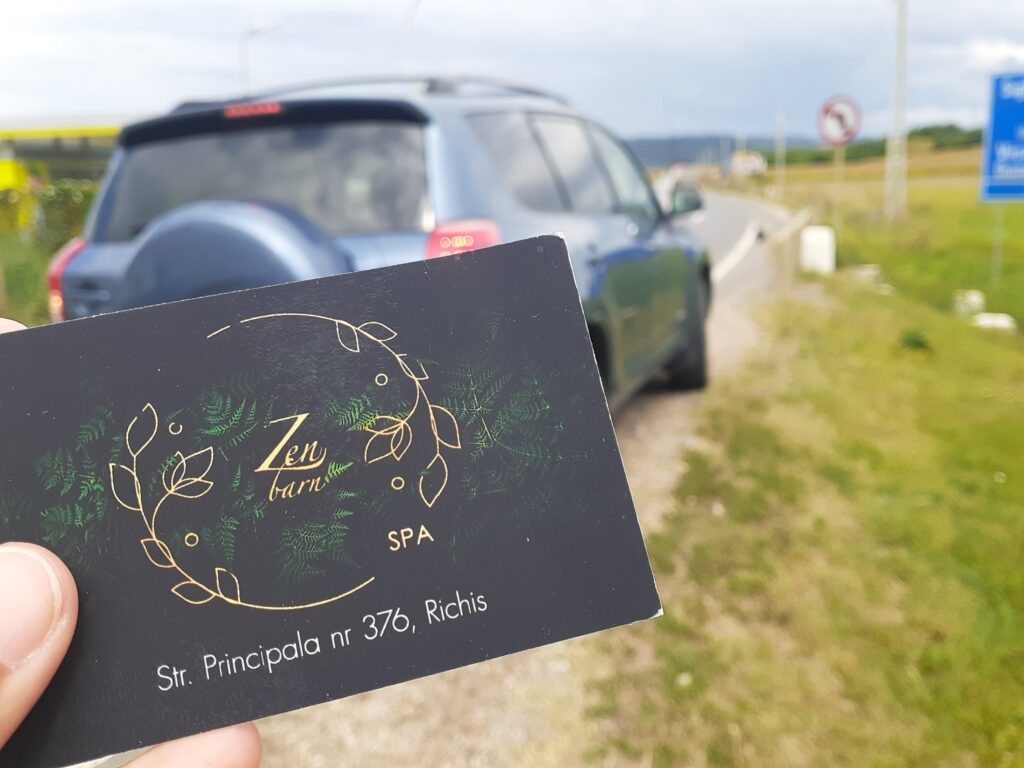
We kept walking and raising our hands when we saw cars coming. After a few cars passed, some of which drove very aggressively, one blue car slowed down and stopped. It was Elena and her partner, who run a spa massage business in the area. She had lived in the UK and spoke very good English. She agreed to give us a lift to the nearby Dumbrăveni railway station.
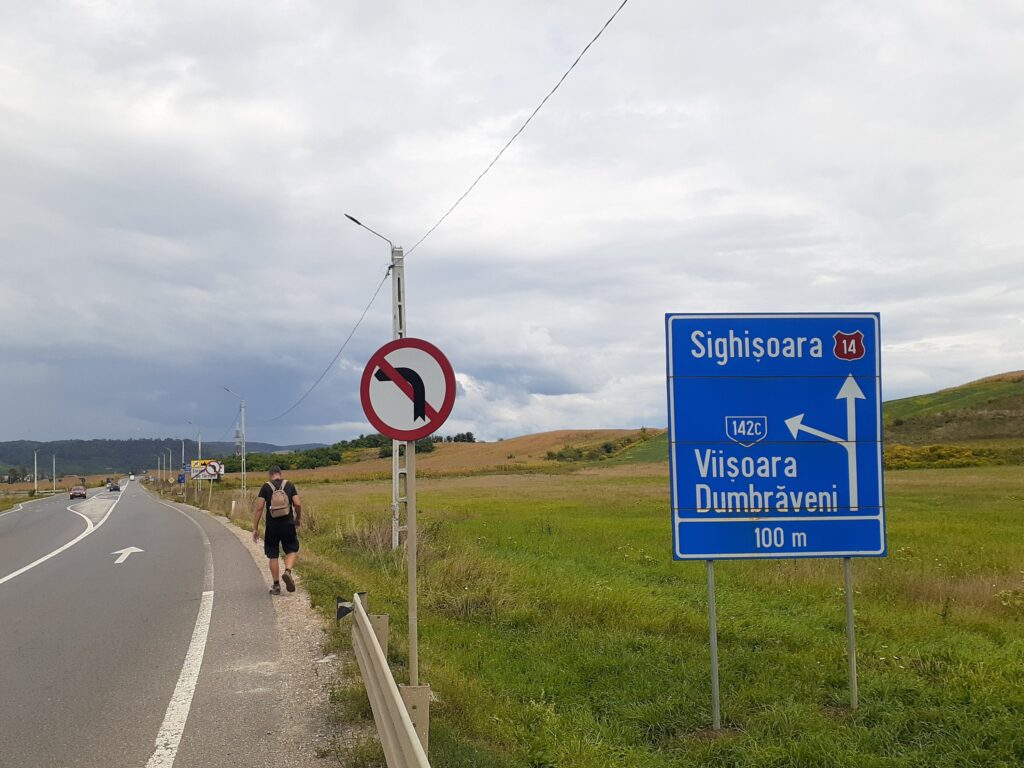
After being dropped off at an intersection near Dumbrăveni railway station, we tried hitchhiking again. If possible, it would be ideal if a driver could give us a lift to Sighişoara.
At this time there was a train from Dumbrăveni to Sighişoara leaving in half an hour, so we decided to try hitchhiking until the last minute and if not, to return by train.
We were standing near the railway station, at the junction with the main road to Sighişoara, but the cars did not stop easily. To begin with, many cars turned left at this intersection towards the bridge in the direction of the railway station, and only a minority of cars went straight heading towards Sighişoara.
We persisted until the very last minute, but it seemed impossible… and we gave up and tried to cross the bridge towards the railway station.
A van coming from the bridge stopped at an intersection and the young man driving rolled down his window. ‘Sighişoara?’ We asked him and he nodded. We hurried to get into his car.
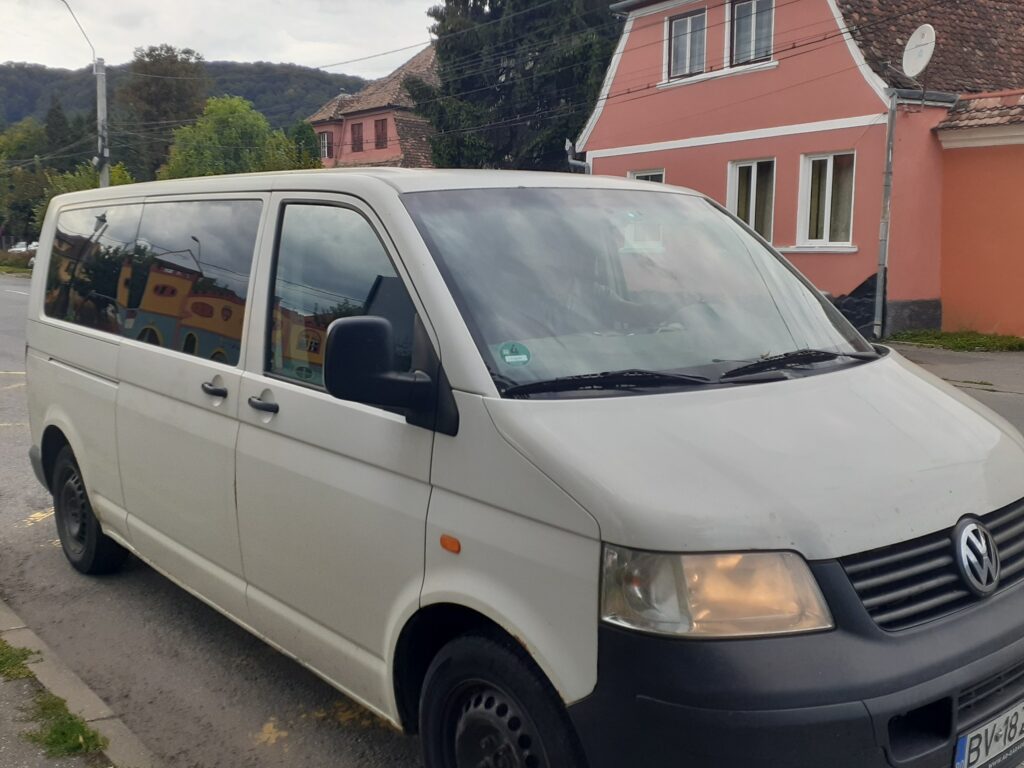
By this time, as we were recalling our hitchhiking experience during this one year trip, we had noticed something. That is, “people who give you a lift have a reason to do so”.
The driver who gave us a lift to Sighişoara was a coffee business owner who said he stopped because he “wanted to give a helping hand to good people in need”. He had seen us standing at the junction when he crossed the bridge a while ago in the direction of Dumbrăveni railway station and thought ‘if these people are still standing here when I come back, I will stop for them’.
During our year-long trip, we were saved by so many people stopping for us, but I am sure everyone had some reason for stopping. Maybe for some drivers, it was just because ‘there was someone walking’.
The young Romanian driver spoke good English, and after a constant conversation we arrived in Sighişoara, where he dropped us off in front of a cheap supermarket called Penny. He stopped for a few minutes in the car park to look up the bus timetable to Bucharest for us, where we were going the next day. It was very kind of him. We thanked him and said goodbye.
The churches and the villeges we visited were impressive, but it was the people we met along the way that made the day even more unforgettable.
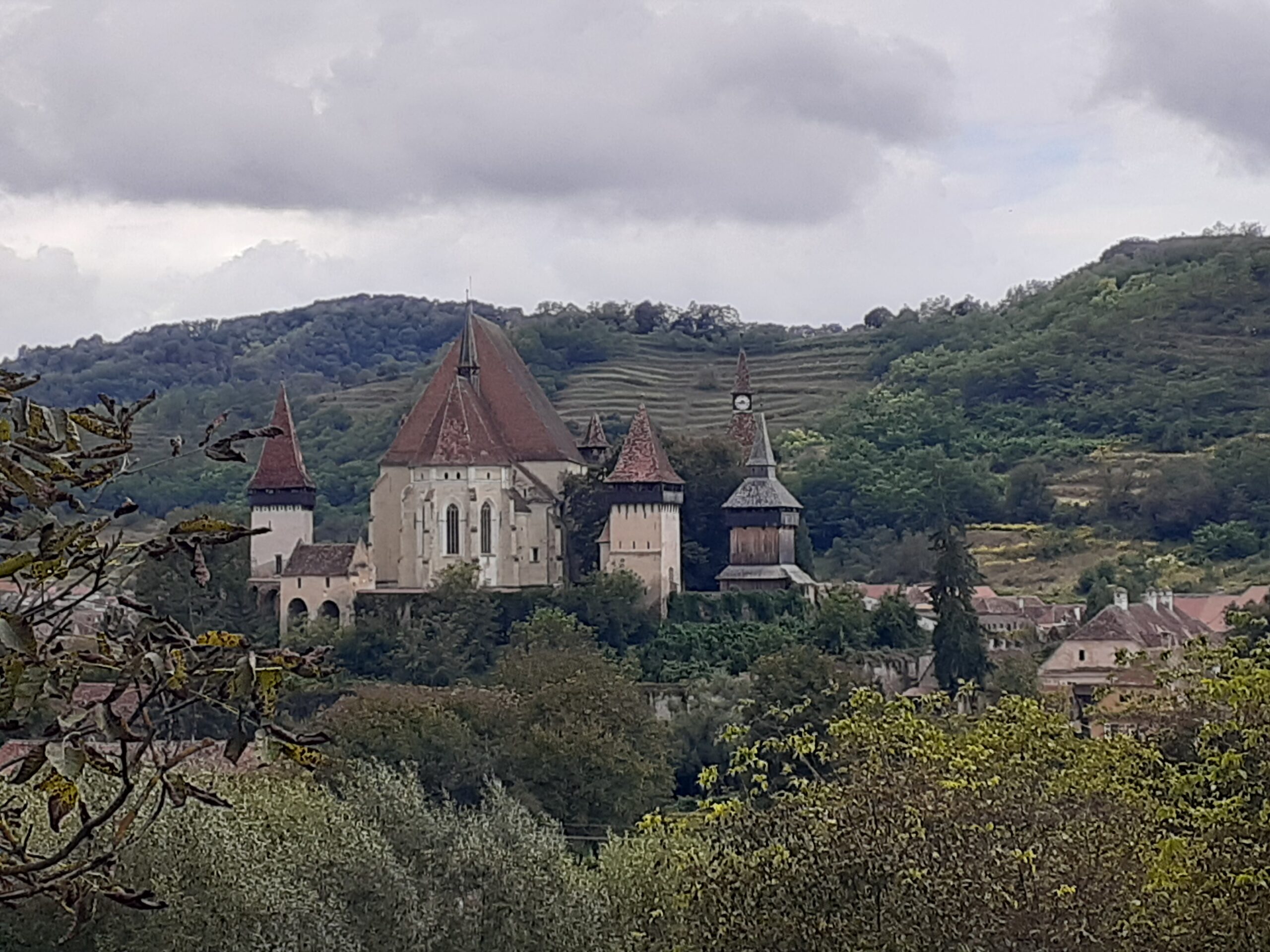


Comment